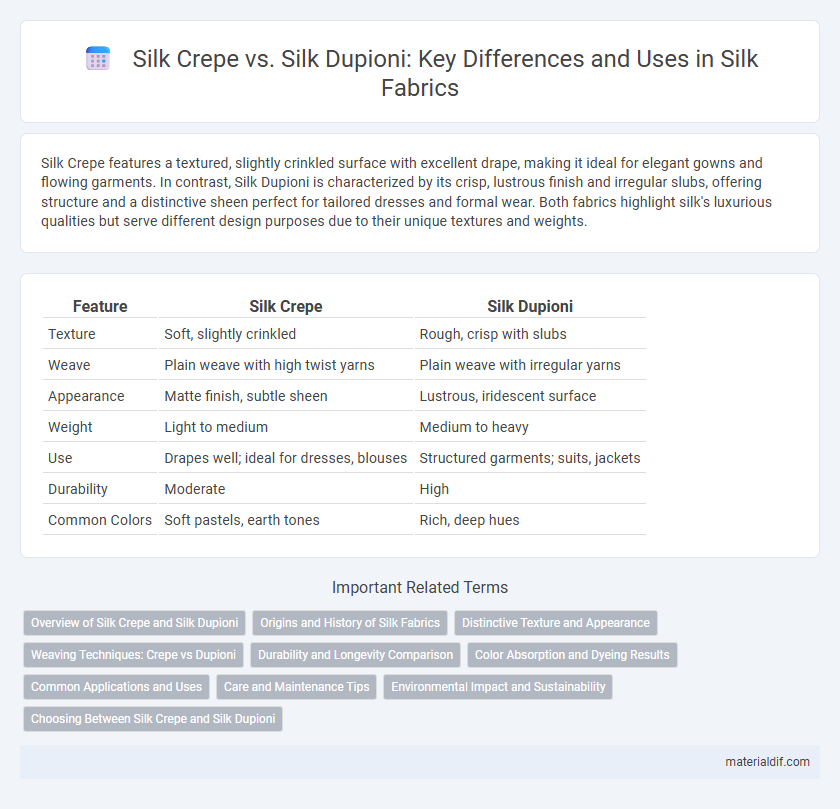Silk Crepe features a textured, slightly crinkled surface with excellent drape, making it ideal for elegant gowns and flowing garments. In contrast, Silk Dupioni is characterized by its crisp, lustrous finish and irregular slubs, offering structure and a distinctive sheen perfect for tailored dresses and formal wear. Both fabrics highlight silk's luxurious qualities but serve different design purposes due to their unique textures and weights.
Table of Comparison
| Feature | Silk Crepe | Silk Dupioni |
|---|---|---|
| Texture | Soft, slightly crinkled | Rough, crisp with slubs |
| Weave | Plain weave with high twist yarns | Plain weave with irregular yarns |
| Appearance | Matte finish, subtle sheen | Lustrous, iridescent surface |
| Weight | Light to medium | Medium to heavy |
| Use | Drapes well; ideal for dresses, blouses | Structured garments; suits, jackets |
| Durability | Moderate | High |
| Common Colors | Soft pastels, earth tones | Rich, deep hues |
Overview of Silk Crepe and Silk Dupioni
Silk Crepe is a lightweight, smooth fabric known for its slightly crinkled texture and excellent drape, often used in elegant garments and dresses. Silk Dupioni features a crisp, lustrous surface with distinctive irregular slubs, providing a textured, structured look ideal for formal wear and upholstery. Both fabrics highlight the natural sheen and luxurious feel of silk but differ significantly in texture and weight, influencing their applications in fashion and design.
Origins and History of Silk Fabrics
Silk crepe and silk dupioni originate from ancient silk-producing regions in China and India, reflecting centuries of textile craftsmanship. Silk crepe, known for its textured surface and fluid drape, developed through complex weaving techniques that enhance its natural crepe effect, while silk dupioni features a crisp texture with distinctive slubs caused by weaving irregularities from two differently twisted silk threads. Both fabrics carry historical significance as luxurious materials used in royal garments and traditional ceremonies, showcasing the evolution of silk weaving artistry across cultures.
Distinctive Texture and Appearance
Silk Crepe features a finely crinkled texture with a matte finish that drapes fluidly, creating an elegant and soft appearance ideal for flowing garments. Silk Dupioni exhibits a crisp, uneven slub texture with a slight sheen, giving it a structured and lustrous look perfect for formal wear and tailored designs. The distinct tactile qualities and visual contrasts between Crepe's smooth grain and Dupioni's irregular slubs define their unique aesthetic appeal.
Weaving Techniques: Crepe vs Dupioni
Silk Crepe is woven using a tightly twisted yarn that creates a pebbly, textured surface with a matte finish, offering excellent drape and softness suitable for delicate garments. In contrast, Silk Dupioni is crafted by weaving irregular, slubbed threads from two different silkworms, resulting in a crisp fabric with a distinctive nubby texture and lustrous sheen ideal for structured garments and formalwear. The key weaving technique difference lies in Crepe's use of tightly twisted yarns for a grainy texture versus Dupioni's combination of uneven yarns producing a unique, shimmering variance.
Durability and Longevity Comparison
Silk Crepe is known for its soft texture and moderate durability, making it suitable for delicate garments that require gentle wear. Silk Dupioni features a tightly woven structure with natural slubs, offering superior strength and enhanced longevity ideal for outerwear and upholstery. The durability of Silk Dupioni surpasses that of Silk Crepe, ensuring longer-lasting fabric performance in high-use applications.
Color Absorption and Dyeing Results
Silk crepe exhibits superior color absorption and rich dyeing results due to its tightly twisted yarns and textured surface, which retain dyes more effectively, producing vibrant and deep hues. Silk dupioni, with its irregular texture and slubbed fibers, yields a more varied and rustic dye appearance that can result in uneven color distribution but enhances visual depth. Both fabrics respond uniquely to dyes, with crepe favored for consistent, saturated coloration and dupioni appreciated for its natural, variegated finish.
Common Applications and Uses
Silk Crepe is commonly used for elegant evening gowns, blouses, and scarves due to its lightweight, textured surface and excellent drape. Silk Dupioni, known for its crisp texture and lustrous sheen, is often chosen for structured garments, bridal wear, and home decor accents like drapes and upholstery. Both fabrics are favored in the fashion and interior design industries for their luxurious appearance and unique tactile qualities.
Care and Maintenance Tips
Silk crepe requires gentle hand washing with mild detergent or dry cleaning to maintain its delicate texture and prevent damage. Silk dupioni demands special care due to its irregular weave and tendency to wrinkle, so dry cleaning is recommended to preserve its crisp finish and vibrant sheen. Both fabrics should be stored away from direct sunlight and moisture to avoid fading and weakening of fibers.
Environmental Impact and Sustainability
Silk crepe production typically involves traditional sericulture with less chemical processing, resulting in a lower environmental impact compared to silk dupioni, which often undergoes more intensive treatments and synthetic finishing. The sustainability of silk crepe is enhanced by its biodegradable fibers and minimal water pollution, whereas silk dupioni's heavier dyeing and weaving processes can increase resource consumption and waste. Choosing silk crepe supports eco-conscious fashion by reducing chemical use and promoting biodegradable textile options.
Choosing Between Silk Crepe and Silk Dupioni
Silk Crepe offers a lightweight, slightly crinkled texture ideal for flowing garments, while Silk Dupioni features a crisp, lustrous finish with natural slubs, perfect for structured designs. When choosing between Silk Crepe and Silk Dupioni, consider the desired drape and formality of the garment; Crepe suits elegant dresses, while Dupioni excels in tailored jackets and bridal wear. Fabric durability and sheen differences also influence the selection, with Dupioni providing a more rigid feel and pronounced shine compared to the softer, matte appearance of Crepe.
Silk Crepe vs Silk Dupioni Infographic

 materialdif.com
materialdif.com